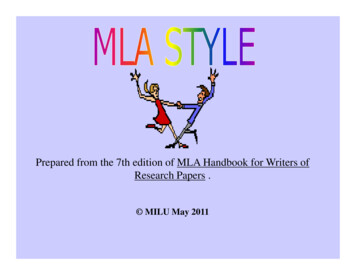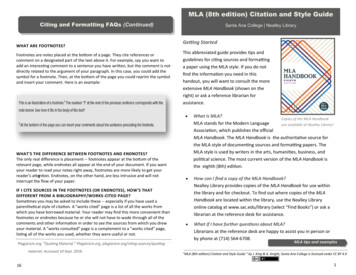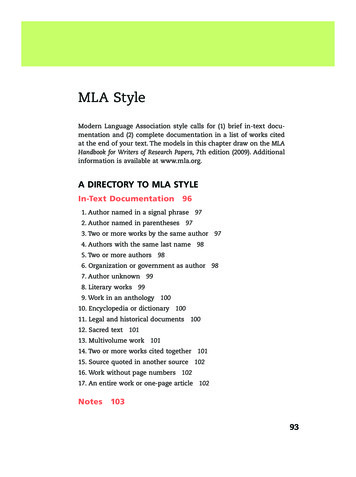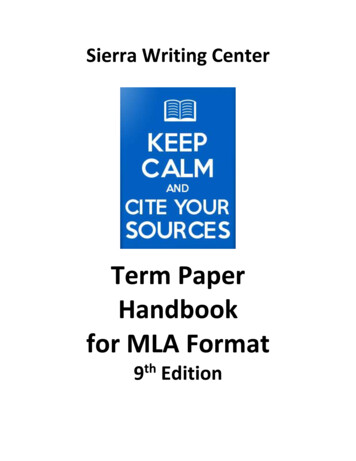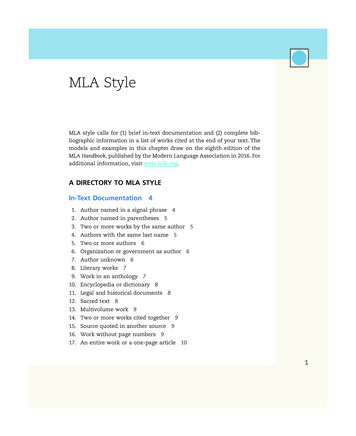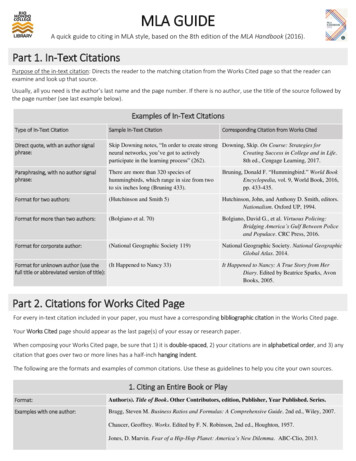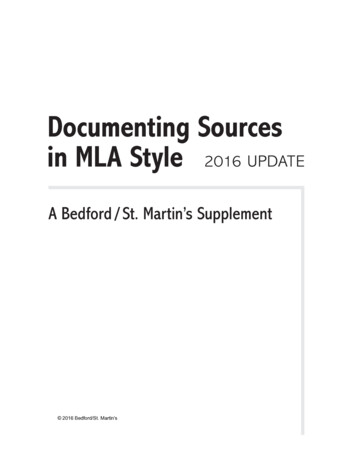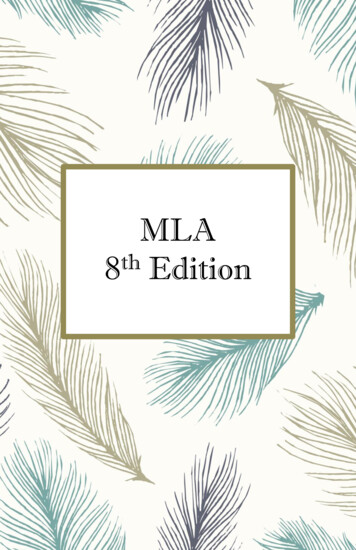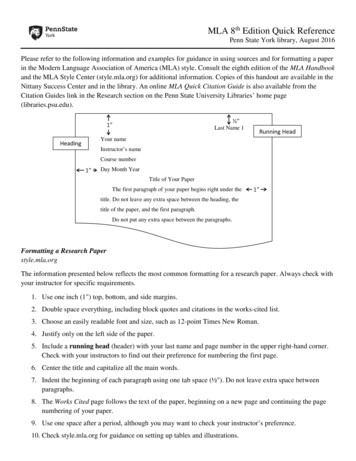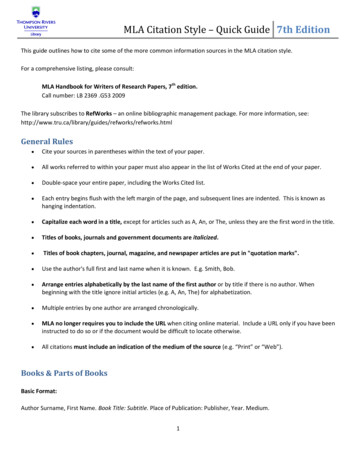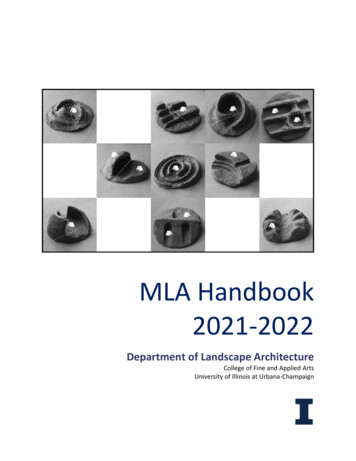
Transcription
MLA Style, 9th EditionContentsIntroductionFormatting Your DocumentFormatting QuotationsFormatting Source TitlesFormatting In-Text CitationsFormatting the Works CitedAdditional Formatting OptionsExamples of In-Text Citations and Works-Cited EntriesSample Paper and Works CitedIntroductionMost college-level instructors ask students to follow a particular formatting style. You may be asked touse the Modern Language Association (MLA) formatting style when you write papers for English orother humanities courses. If you aren’t sure whether to use this format, check with your instructor.MLA Style guidelines cover two main elements: document format and citation format. Documentformat specifies details such as headings, margins, spacing, and page numbers. Citation format coversintegrating and crediting information that is summarized, paraphrased, or quoted from a source.Below is a condensed overview of various aspects of MLA Style. However, your best resources are theMLA Handbook (ninth edition), widely available for purchase, and the companion Style Center found atstyle.mla.org. The MLA Handbook is also available in most libraries’ reference sections. If you’reenrolled in a composition class or even a literature class, your textbook may have a section on MLAStyle as well.The ninth edition of the MLA Handbook continues to provide a universal set of guidelines adaptable toany source in whatever format you might access (print, online, audiovisual, etc.). It’s crucial tounderstand the sources you’re using as well as how and why you’re using them; MLA allows forflexibility when choosing what it identifies as core and supplemental elements. These elementsdetermine what to include in citations and how to present that information both in text and on theworks-cited page. Please read the sections below carefully for further guidance on formatting theseareas according to the MLA Handbook.Formatting Your DocumentFirst PageAt the top left of your first page only, double-space the following information, beginning one inch fromthe top of the page and flush with the left margin:Your full nameJane SmithYour instructor’s nameProfessor MillerThe course name and numberEnglish 213The date4 June 2021Each item should appear on its own line, and the lines should be double-spaced. On the next line,center your title in plain type with no formatting changes (e.g., no italics, bold fonts, all caps, orquotation marks). However, if your title contains the names of other sources, format those names asyou would in the essay’s body (e.g., italicizing book or film titles). Capitalize all major words in yourtitle, excluding articles, prepositions, and coordinating conjunctions. The text of the paper begins onedouble-spaced line below the title, with the first line of all paragraphs indented one-half inch.Title PageFor individually authored papers, MLA doesn’t require a title page, so if your assignment instructions
request one, format it according to your instructor’s preferences. However, if your paper is part of agroup project, MLA recommends using a title page to include the names of the various groupparticipants. In the top left corner, include the names of the participant’s, each on their own line:Full name of participant oneFull name of participant twoFull name of participant threeIn the same heading, below the participants’ names, include all other items in the chart above(instructor’s name, etc.), each on its own line, at the top left of the page. Then, place the paper’s titleseveral lines below this information, centered halfway down the page.Running Head and Page NumbersEvery page should have a running head in the top right corner, one-half inch from the top edge of thepaper and flush with the right margin. This running head should contain your last name followed by aspace and the page number (e.g., Smith 2). Do not include p. with the page number or follow it with aperiod, hyphen, or any other symbol. If the paper has more than one author and all authors’ lastnames do not fit in the running head, it should include only the page number(s) throughout the paper.Page numbers should continue consecutively from the first page through the works-cited page(s).Use your word processor to create a running head with name(s) and page numbers instead of typingthem onto each page so that page numbers automatically adjust as you revise.Internal HeadingsInternal headings can be helpful organizational tools in longer research projects but should not beoverused. Shorter, essay-length works usually do not need headings. If you’re using headings, MLArecommends styling them so a first-level heading has the most prominence, and any subheadings areincreasingly less prominent. For example, if you use bold on a first-level heading, a second-levelheading could be in non-bold font, and a third-level heading could be in non-bold, italicized font.Headings should use the same font as the paper and should not use all caps; however, MLA does notgive any other specific guidelines for styling the font of headings.Do not center or indent headings. Instead, align them with the left margin. If you include any level ofa heading, the essay should contain at least one additional heading at that level. Therefore, if youinclude one first-level heading, you should include another first-level heading in the paper. Also,continue double-spacing when inserting headings so that one blank line space appears above andbelow each heading.Margins, Indentations, and SpacingSet your margins at one inch on each side (top, bottom, left, and right) of the document. Indent thefirst line of each new paragraph and all lines of any block quotations an additional one-half inch.Double-space all lines throughout your paper, including the heading, block quotations, notes, andworks-cited page; do not use the Enter/Return key to double-space because it will cause spacingissues when you add or change content. Include a single space between the end punctuation for onesentence and the start of the next.FontUnless you instructor has other specific preferences, use a standard-sized (e.g., 11- to 13-point),readable font in which the regular style is easily differentiated from the italic style (e.g., Times NewRoman). MLA also notes that the hyphenating feature should be turned off in your word processingprogram. View a sample MLA-formatted paper.Tables and FiguresPlace any tables or illustrations within the body of the text, as close as possible to the text theyreference. One double-spaced line below your text, label the table with the word Table and anapplicable arabic numeral, numbering tables consecutively throughout the paper. One double-spacedline below this label, include the table’s title. Capitalize the title as you would other titles. If the table’s
title is longer than one line, double-space it, as in this example:Table 1Numbers of Degrees Conferred at Online Schools Compared to Numbers Conferred at More TraditionalUniversities and Colleges, 2016-2020Illustrations such as graphs, charts, and photographs are labeled as Figures (abbreviated to Fig.without special formatting) and are also numbered consecutively using arabic numerals. Beneath eachillustration, type the abbreviation Fig. followed by the figure number and the caption on the same line.Double-space captions and labels, and align them with the left margin of the paper:Fig. 1. A daughter of Niger (Inigo Jones), from David Lindley, editor; Court Masques; Oxford UP, 1995,p. 159.If the caption provides complete citation information for the source, and you do not cite this sourcewithin the body of your text, you need not repeat the source information on your works-cited page.Cite it as you would on the works-cited page, but do not invert the names of the author(s) or artist(s):Fig. 2. Andrew Wyeth. Study for the Quaker. 1975, High Museum of Art.Formatting QuotationsMLA Style encourages student writers to focus on their research and ideas, using quotationsthoughtfully and only to supplement the ideas expressed in a paper, presentation, or other type ofproject. Quotations should be as brief as possible and should provide specific, applicable insight that’sunusually well-stated or intelligent. Your original writing takes priority and should fill most of the spacein your paper.When you choose to use quotations from a source, always quote words, phrases, or sentences exactlyas they appear in the original source, using double quotation marks (“like this”). Use single quotationmarks (‘like this’) when including a quotation within another quotation. In your paper, the spelling,capitalization, punctuation, italicization, or accents in the quotation should look just as it does in thesource. However, a superscript number for an endnote or footnote that appears in the source shouldnot be included when you quote from it. If you need to add emphasis, include extra notations, or editquoted material to flow smoothly with the grammar of your sentence, follow the guidelines below.Signal PhrasesNever allow quotations to stand independently from your own sentences; instead, integrate eachquotation into your own writing, making sure to construct grammatically complete sentences. You maychoose to either use a signal phrase or write a complete sentence followed by a colon and then thequotation:Davis claims that Andrew Carnegie institutionalized philanthropy, which “thereby established animpersonal, self-perpetuating mechanism for redistributing economic capital into symbolic capital at acrucial moment in the history of US labor relations” (784).Abrams sets up an important binary: “Throughout the long history of this way of thinking, theantithesis and opponent of unitive love had been self-love, selfhood, egocentrism.”Choosing TenseThe ninth edition of the MLA Handbook doesn’t specify which verb tense to use, so check with yourinstructor; however, generally you’ll use present-tense verbs when writing about literature.Keats likens Porphyro to “a throbbing star / Seen mid the sapphire heaven’s deep repose” (318–19).
When discussing secondary research, you can also use present tense:Gioia says that Frost’s poetry is defined by “innovation and originality” (188).However, you might also use perfect tense:Gioia has said that Frost’s poetry is defined by “innovation and originality” (188).When discussing events that took place at a definite time in the past, use the past tense:Keats’s death was neither quick nor painless; Severn listened to the young poet drown in his ownmucus for seven hours (Ward 402).Inserting or Changing MaterialUse brackets [ ], not parentheses ( ), to enclose letters, words, or phrases that you change or add toa quotation, either for clarification or to fit the grammar of your sentence:Discussing Flannery O’Connor’s work, Hoffman notes that “[t]he spirit of evil abounds, and thepremonition of disaster is almost invariably confirmed” (82).Above, the uppercase T in the source text is lowercased to fit the grammar of the sentence; thebrackets indicate that change. Similarly, if you need to capitalize the first letter of a quotation and it isnot capitalized in the source, enclose the capital letter in brackets:Writing about “A Good Man is Hard to Find,” Hoffman notes, “[T]he premonition of disaster is almostinvariably confirmed” (82).Clarification is also sometimes needed when quoting. If your readers wouldn’t understand a quotationwithout explanation, brackets can provide necessary context:Seward confesses, “I seemed to wish to keep him [Renfield] to the point of his madness—a thingwhich I avoid with the patients as I would the mouth of hell” (Stoker 61).The writer adds the character name Renfield in brackets to clarify who him refers to in the quotation.Omitting MaterialUse three spaced ellipsis points ( . . . ) to clarify when you’ve left out words within a sentence:The creature “approached; his countenance bespoke bitter anguish . . . while its unearthly uglinessrendered it almost too horrible for human eyes” (Shelley 241).Use a period and three ellipsis points (. . . . ) when omitting an entire sentence or more from thequotation:Frankenstein recounts, “One secret which I alone possessed was the hope to which I had dedicatedmyself. . . . I seemed to have lost all soul or sensation but for this one pursuit” (Shelley 278).Including Supplementary InformationIf you want to emphasize a word or phrase in a quotation, italicize the word(s) and insert a semicolonand the words my emphasis or emphasis added after the locator information in the in-text citation:Lanyon recalls of his reaction to Hyde, “At the time, I set it down to some idiosyncratic, personal
distaste, and merely wondered at the acuteness of the symptoms; but I have since had reason tobelieve the cause to lie much deeper in the nature of man” (Stevenson 48; my emphasis).If you quote a text that misspells a word, uses an older version of a word, or spells a word in adifferent form of English, include the word sic in brackets after the unusual or inaccurate spelling:Musing about death, C. S. Lewis writes, “What on earth is the trouble about there being a rumour [sic]of my death? There’s nothing discreditable in dying: I’ve known the most respectful people do it!” (6768).Formatting Short Quotations From ProseQuotations of four lines or fewer on your page (not necessarily in the original) are usually incorporatedinto your own sentences. You can use a signal phrase (author’s name plus a verb such as says,concurs, reports, questions, remarks, etc.) to introduce the quotation:The main character in Joanne Greenberg’s I Never Promised You a Rose Garden remarks, “We livedsimple lives. We lived good lives. We lived in dignity” (22).Or you can incorporate a short quotation of a word or phrase directly into the flow of your sentence:The main character in Joanne Greenberg’s I Never Promised You a Rose Garden believes that she andher friends lived “simple” and “good lives” (22).As the examples show, the closing double quotation marks belong directly after the final word of thequotation and before the opening parenthesis; the period goes after the closing parenthesis becausethe citation is considered part of the sentence in which the borrowed material appears.Formatting Long Quotations From ProseQuotations that are longer than four lines of text on your page (not necessarily in the original) shouldbe included in block quotation format. MLA Style provides specific standards for formatting a blockquotation: Introduce the block quotation with a sentence followed by a colon, or introduce the blockquotation with a signal phrase that allows for different punctuation (or none at all).Before a block quotation, when a verb such as writes or explains falls at the end of a signalphrase, follow it with a colon rather than a comma.Start the block quotation on a new line indented one-half inch from the left margin.Omit quotation marks around the block quotation.Maintain any quotation marks present in the passage you’re quoting but do not insert any newquotation marks.Place the final punctuation mark of the block quotation before the parenthetical citation.Justify the quotation’s alignment on the left but not on the right.Double-space the quotation.Refer to this example of a block quotation in MLA Style.Formatting Short Quotations From PoetryWhen quoting poetry, you should identify where each line ends. If you’re including a short quotation(three lines or fewer from the original poem) within your essay, use a forward slash with one space oneither side ( / ) to indicate where a line breaks, and retain the capitalization from the original source:In “Mother to Son,” Hughes uses the vivid metaphor of an aging set of stairs to show the mother’slife has included “splinters / And boards torn up, / And places with no carpet on the floor” (30).
If your quotation includes lines from two stanzas (i.e., a line at the end of one stanza followed by thefirst line of the next stanza), indicate the stanza break with two forward slashes ( // ):Using reverse chronology, Sexton reminisces, “My daughter, at eleven / (almost twelve), is like agarden. // Oh, darling! Born in that sweet birthday suit” (lines 1-3).MLA Style provides some additional standards to follow when citing poetry: If the poem is longer than one page and does not contain line or division numbers, citequotations by page number because counting lines to record line numbers would requirereaders to do the same. If the poem or song does have line or division numbers, cite the line or division numbersinstead of page numbers in the parenthetical citation. To cite line numbers, include the wordline or lines in the first citation only: (line 13) or (lines 139-45). Do not use abbreviations toindicate the line number. After the initial citation, include the numbers alone:o First instance: (lines 23-24)o Second instance: (25-27)When poetry or other forms of verse contain a division, such as an act, scene, canto, book, or part,cite by division and line(s) in the in-text citation: (bk. 20, lines 30-33) or (canto 9). In addition, usearabic numerals, as in the Shakespearean example below, to cite act, scene, and line numbers:In his misery, King Lear exclaims, “How sharper than a serpent’s tooth it is / To have a thanklesschild” (Shakespeare 3.3.23–24).Formatting Long Quotations From PoetryIf you want to quote more than three lines of a poem or song, set up a block quotation and cite thelines as you would a prose passage:Robert Frost’s poem “Stopping by Woods on a Snowy Evening” conveys the speaker’s weariness:The only other sound’s the sweepOf easy wind and downy flake.The woods are lovely, dark, and deep,But I have promises to keep,And miles to go before I sleep.And miles to go before I sleep. (11–16)Any line of poetry in a block quotation that extends to a second line should receive an extra indentwhere it begins on the subsequent line. In addition, if the poem you’re citing has any unusualindentations—a line of the poem may begin at the middle of the line space on the page, for instance—reproduce that special formatting in your block quotation. For other special formatting when quotingpoetry, follow these standards: Position the in-text citation on a subsequent line, flush with the right margin, if it will not fit onthe same line as the end of the quotation.Place an ellipsis at the end of a line if your quotation stops before the end of the sentence: ButI have promises to keep . . .Use a longer ellipsis (about the length of one of the poem’s lines) to omit an entire line from ablock quotation of poetry:The only other sound’s the sweep
Of easy wind and downy flake.But I have promises to keep,And miles to go before I sleep. (11-15)Formatting Long Quotations From DramaWhen quoting dialogue from a play, set the quotation off from the text of your essay by starting it ona new double-spaced line and indenting it one-half inch from the left margin. Before quoting, list thename of the character who is speaking in all caps, followed by a period: WILLY. If the character’sspeech goes onto any additional lines, indent them another one-half inch beyond the start of the firstline. When shifting to a new character’s speech, begin it one-half inch from the left margin, on a newline aligned under the beginning of the first character’s speech. As with a block quotation for poetry, ifthe in-text citation doesn’t fit at the end of the quotation, place it one double-spaced line below thelast line of the quotation, flush with the right margin:Years later, Willy continues to hold tightly to his blinders, refusing to see how his actions shaped hissons’ lives. Discussing missed chances for Biff, Willy becomes offended when Bernard confronts him:BERNARD. Well, don’t get sore.WILLY. What are you trying to do, blame it on me? If a boy lays down is that my fault?BERNARD. Now, Willy, don’t get—WILLY. Well, don’t—don’t talk to me that way! What does that mean, “What happened?”(Miller 94; act 2)When citing a commonly referenced modern prose work like the novel or play above, list the author (ifnot listed in the signal phrase) and page number followed by a semicolon and important identifyinginformation. In this case, the quotation above is found in act 2 of Death of a Salesman. Other worksmight be identified by section, chapter, or book: (sec. 3), (ch. 7), or (bk. 2). You may also listmultiple identifiers as appropriate: (Smith 45; bk. 3, ch. 2). Abbreviate the identifier only if it’s in theMLA Handbook’s current list of accepted abbreviations (found in Appendix 1 on pages 294-95 in theninth edition), such as ch., sec., or vol.Formatting Quotations From an Indirect SourceIdeally, all quotations should come from the original source, so make your best efforts to locate anysource you’d like to quote in your writing. When this isn’t possible, however, you may cite from anindirect source. If the passage you quote, paraphrase, or summarize from an indirect source is itself aquotation from another source, use the abbreviation qtd. in (“quoted in”) before naming the indirectsource in your parenthetical citation, enclosing the quoted material with double quotation marks:In the nineteenth century, American women’s rights activist Elizabeth Oakes Smith argued thatmarriage should entail “the deepest emotions of the heart, the highest affinities of intellect, andthe utmost sense of beauty . . . to make it more desirable” (qtd. in Stoehr 118).In addition, on the works-cited page, cite the work you’re viewing, not the unavailable original source:Stoehr, Taylor. Free Love in America: A Documentary History. AMS Press, 1979.Formatting Source TitlesAlways transcribe the title of a work from its title page, not the cover or running head at the top of
each page. Do not preserve any non-standard formatting, such as a title in all caps or all lowercase. Atitle that appears as READING AND COMPOSITION FOR COLLEGE WRITERS on the cover of a textbookwould appear as Reading and Composition for College Writers in your document.If your source names the title of another source within its own title, write the other source’s titlefollowing these standards: Italicize a title normally in italics when it appears within a title enclosed in quotation marks(e.g., “An Analysis of Walker Percy and Laura Mulvey: The Moviegoer’s Conversion”). Use single quotation marks around a title normally enclosed in double quotation marks if itappears in a title that is itself within quotation marks (e.g., “Dialect, Metaphor, and Imagery in‘Mother to Son’”). Retain double quotation marks around a title normally enclosed in double quotation marks if itappears in a title that is italicized (e.g., Frost in the Night: “Stopping by Woods on a SnowyEvening” and Nighttime Imagery in Robert Frost’s Poetry). Remove italics and use no special formatting for a title normally italicized that appears withina title that is itself in italics (e.g., Modernity and Loss in Death of a Salesman).Generally, a title is italicized if the source is self-contained and independent; in contrast, the title for asource that’s part of a larger work is placed in quotation marks. The chart below illustrates how toformat the titles of different source types within your draft.ItalicsBookPlayLong Poem Published as a Book (e.g., ParadiseLost)NewspaperMagazine JournalDissertationWebsite (Not a Single Webpage)Online Database (e.g., JSTOR)FilmTelevision or Streaming SeriesRadio ProgramPodcastMusic AlbumLive PerformanceLong Musical Composition Identified by NameWork of Visual ArtVideo GameAppQuotation MarksEssay or Chapter in a BookEncyclopedia EntryJournal ArticleNewspaper ArticleMagazine ArticlePress ReleaseInterviewShort StoryPoemWebpage (Not an Entire Website)Episode of a Television or Streaming SeriesEpisode of a Radio BroadcastPodcast EpisodeSongLecture or SpeechTweetBlog PostIn a title or subtitle, capitalize the first word, the last word, and words that follow hyphens incompound forms (e.g., “Spanish-Speaking Countries”). Then, follow these rules for determiningwhether individual parts of speech should be capitalized:CapitalizedNot Capitalized (Within a Title)NounsArticles (a, an, the)PronounsPrepositions (e.g., against, as, between, in,Verbs (Including Short Verbs Like Is and Are)of, to)AdjectivesCoordinating Conjunctions (for, and, nor, but,Adverbsor, yet, so)The to in Infinitives (e.g., to Play, to Bite)Subordinating Conjunctions (e.g., After, Although,Because, Before, If, That, Unless, Until, Where)Titles for some sources require neither italics nor quotation marks: Scripture (e.g., the Bible, the Koran, Genesis, the Gospels, the Talmud)
Laws, acts, and similar political documents (e.g., the Magna Carta or the Bill of Rights)Musical compositions titled by form, number, and key (e.g., Mozart’s Symphony no. 25 in Gminor)Series (e.g., Landscape Performance Series)Conferences, workshops, courses, and events (e.g., Thomas R. Watson Conference,Introduction to Physics, or English 102)Earthworks, buildings, and ancient artworks (e.g., Table Rock, The Fox Theatre, or Mask ofAgamemnon)Below you’ll find some examples of correct title format for different types of sources: A headline on the front page of USA Today declares, “Student Loan Debate Rages On.” Literacy: A Critical Sourcebook includes “Community Literacy,” an article about students whohelped create a course addressing local political and social issues. “And Maggie Makes Three,” a particularly compelling episode of Fox’s long-running sitcom TheSimpsons, demonstrates the strength of Homer’s commitment to his family. My favorite song on Wilco’s CD Sky Blue Sky is “Either Way.” Professor Singer’s lecture “The Fall of the Roman Empire” bored students in this semester’sHistory of Western Civilization course. The Landscape Performance Series aims to embrace design, development, and sustainability inthe landscaping process. In 2016, the Thomas R. Watson Conference was held at the University of Louisville, featuringthe theme “Mobility Work in Composition: Translation, Migration, Transformation.”Formatting In-Text CitationsTo credit a source properly, you must cite it in two places: where you quote, paraphrase, orsummarize the source within the paper (called an in-text or parenthetical citation) and at the end ofthe paper in the works-cited list, which will include the full publication information for each source youuse within the essay.Each in-text citation should begin with the shortest piece of information from the beginning of thecorresponding entry in the works-cited list. This information is typically the last name of the author(s)or the title if the source doesn’t have an author. You must include an in-text citation for everyquotation, paraphrase, or summary from an outside source. Only when you mention a work in passingcan you omit an in-text citation. For example, if you refer to a film once in your paper, it does notneed to be cited; however, if the film is substantive to the paper and is referenced multiple times, itmust be cited.Author Last Name and Page NumberThe in-text citation should be placed after the information from your source, usually but not always atthe end of a sentence. In a typical in-text citation, like this citation for a paraphrase, the page numberfalls after the author’s last name, separated from it by a single space:In the late 1890s, after some of her short stories were repeatedly rejected for publication, Chopinexperienced a dry, silent time in her writing career (Toth 315).If a sentence includes multiple quotations from different sources, every quotation may need its ownin-text citation so readers can more easily pair each in-text citation with its source. In such sentences,an in-text citation may be placed directly after its corresponding quotation:While most critics explore Kate Chopin’s connections to the south in her “stories set in the sensualatmosphere of the Louisiana she remembered” (Toth 20), some of her work reveals the “awakening”in her “inner spirit” that she experienced during her honeymoon in Europe (Sloane 282).You may identify the author in a signal phrase so your citation contains only locator information. Whenyou first include a person’s name (an author or an individual you’re writing about), include it in full:
Emily Toth points out that Kate Chopin was quickly becoming a celebrity by the early 1890s and waseven chosen as a “representative Southern Writer” in Southern Magazine (245).Thereafter, only include the last name(s):As Toth explains, both regional and national news outlets of the day reviewed Chopin’s work favorably(299).If you’re citing an editor, translator, performer, or other creator in the place of an author, cite the lastname as usual, without any abbreviations for the person’s function: (Lightner 45). Additionally, whenyou’re writing about, quoting, or paraphrasing someone who is famous, such as Shakespeare, the lastname can be used each time.If a source is only one page in length, MLA doesn’t require a page number in an in-text citation, butcheck your instructor’s preferences to determine whether they require a page number.If a source does not have locator information, the in-text citation should include the author oridentifier but not locator information. For example, citations for electronic sources without numberedpages or numbered paragraphs should usually include the author only.To cite quotations spanning two pages, give the complete number range for numbers up to 99: (Toth78-79). For higher numbers, you can repeat only the last two digits in the second number: (Toth 12324). Additionally, if your in-text citation includes multiple references to non-consecutive pages fromthe same source, separate the applicable page numbers with commas: (Toth 163, 167, 170).Citing an author’s last name won’t always be possible, and many sources won’t have page numbers.Below, you’ll see explanations for accurately noting other types of identifier a
MLA Handbook (ninth edition), widely available for purchas e, and the companion Style Center found at . style.mla.org. The MLA Handbook is also available in most libraries' reference sections. If you're enrolled in a composition class or even a literature class, your textbook may have a section on MLA Style as well.
